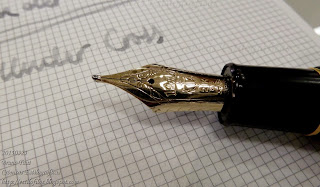But the brick and mortar shop is still there, as has been the case since 1931. It is fairly spacious and cozy, and only offers a small selection of pens —all Pilot and Namiki—, a couple of ink brands —Pilot and J. Herbin—, and a nice selection of papers and notebooks.
This limited offer of pens would only make this shop as many others, but Asahiya Kami does offer a unique pen —a red-urushi Pilot Custom 845— and a broader selection of nib points on models Custom 845 and plunger-filler Custom 823. The later is also available in the apparently discontinued white transparent version.

The red urushi (vermillion) Pilot Custom 845 with a regular BB nib. This pen in this color is exclusive to Asahiya Kami Bungu.
Other pen shops in Japan have offered similar options in the past. Maruzen had limited edition Custom 845s in green and in blue urushi, and some years ago offered the option of falcon and waverly nibs at least on the Custom 823. These options, however, are no longer available, and make Asahiya Kami all the more appealing. The drawback of all these limited releases is having to pay the full catalog (MSRP) price (JPY 50000 for the Custom 845 and JPY 30000 for the Custom 823) while some other shops in town offer them at discount prices, although with no fancy options.

Two Custom 823. The fully transparent unit sports a waverly nib. This option is not offered in the Pilot catalog, but is sold at Asahiya Kami stationery.
Exclusivity, after all, has a price.
Asahiya Kami Bungu will be included in the list of pen shops in Tokyo in this blog.
Platinum 3776 (1984) – Parker Quink Blue
Bruno Taut
Nakano, April 17th, 2015
etiquetas: Tokyo, mercado, Pilot
Bruno Taut
Nakano, April 17th, 2015
etiquetas: Tokyo, mercado, Pilot
















































